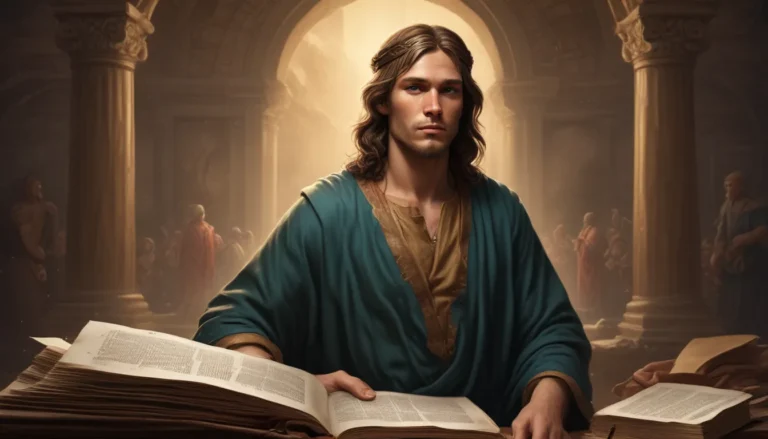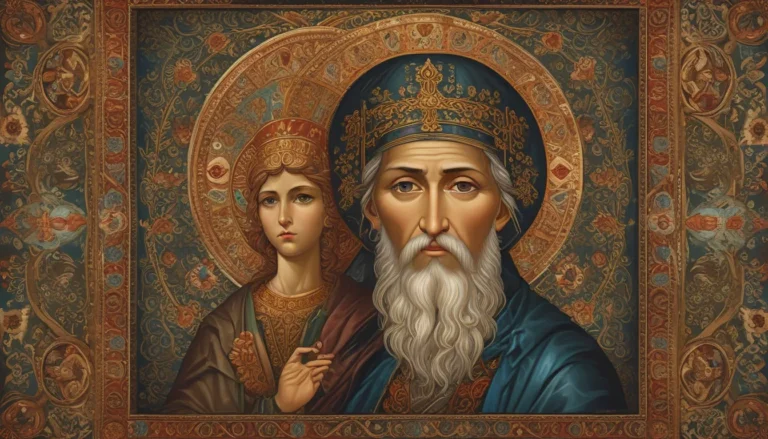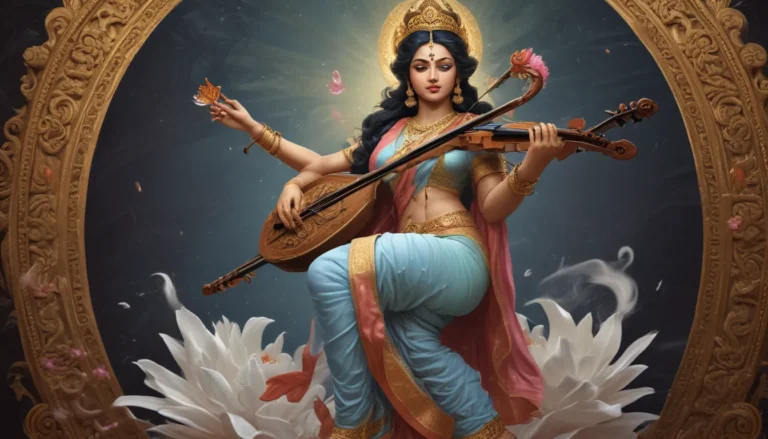The images in our articles may not match the content exactly. They are used to grab your attention, not to show the exact details in the text. The images complement the text but do not replace it.
Welcome to the world of Caodaism, a unique and fascinating religion that has captivated followers worldwide with its blend of diverse faith traditions. In this comprehensive guide, we will uncover 18 intriguing facts about Caodaism, shedding light on its history, beliefs, rituals, and impact on Vietnamese culture. Whether you are a curious observer or a potential follower, this article aims to provide you with a deep understanding of the key aspects of Caodaism.
The Origins of Caodaism: A Uniquely Vietnamese Religion
Caodaism, also known as the Cao Dai religion, traces its roots back to 1926 in the city of Tây Ninh, Vietnam. Founded by Ngo Van Chieu, Caodaism emerged as a syncretic religion blending elements of Buddhism, Taoism, Confucianism, and Christianity. Chieu claimed to have received divine revelation from spiritual entities including Buddha, Jesus Christ, Confucius, and Muhammad, shaping the core beliefs of Caodaism.
Beliefs and Teachings: A Quest for Spiritual Enlightenment
Central to Caodaism is the worship of a Supreme Being known as Cao ?ài, underpinning the pursuit of spiritual enlightenment and harmony with the divine. This unique blend of beliefs emphasizes the importance of reincarnation, karma, and the pursuit of universal love and harmony. Caodaism promotes interfaith dialogue and unity, bridging different religious traditions to foster understanding and peace.
The Divine Eye: Symbol of the All-Seeing Supreme Being
A prominent symbol in Caodaism is the Divine Eye, representing the all-seeing power of the Supreme Being. Depicted as an eye inside a triangle surrounded by rays of light, the Divine Eye symbolizes divine providence, guidance, and the omnipresence of the Supreme Being in the lives of Caodaists.
Saints and Spirits: An Extensive Pantheon of Revered Figures
Caodaism recognizes a diverse pantheon of saints and spirits, encompassing religious leaders, historical figures, and mythical deities. Revered figures in Caodaism include Victor Hugo, Sun Yat-sen, and Tr?n H?ng ??o, reflecting the syncretic nature of the religion and its openness to diverse influences.
Reincarnation and Karma: Fundamental Concepts in Caodaism
Caodaists believe in the concept of reincarnation, where the soul undergoes cycles of rebirth into new bodies. The law of karma, central to Caodaist beliefs, asserts that one’s actions in the present life shape their future destinies in subsequent lives. These core beliefs underscore the moral and ethical principles guiding the actions of Caodaists in their pursuit of spiritual growth.
Religious Practices: Prayer, Meditation, and Moral Virtues
Caodaists engage in a variety of religious practices aimed at deepening their spiritual connection and fostering personal growth. These practices include prayer, meditation, attending temple ceremonies, and following a moral code that promotes virtues such as compassion, honesty, and humility. By embodying these values, Caodaists seek to align themselves with the divine principles guiding their spiritual journey.
Gender Equality: Upholding Equal Opportunities for All
Caodaism stands as a proponent of gender equality, offering equal opportunities for men and women to partake in leadership roles and all aspects of religious life. This commitment to equality reflects the inclusive and progressive values at the core of Caodaism, empowering individuals from diverse backgrounds to contribute to the spiritual community.
Social Services: Charity and Humanitarian Work
Central to Caodaism is a strong emphasis on charitable work and social services, embodying the principles of compassion and service to others. Caodaist organizations are actively involved in providing healthcare, education, and humanitarian aid to those in need, demonstrating a commitment to improving the well-being of their communities and society at large.
The Holy See in Tây Ninh: Spiritual and Administrative Headquarters
The Holy See in Tây Ninh serves as the central religious authority of Caodaism, functioning as the spiritual and administrative headquarters of the religion. This grand temple complex stands as a symbol of the rich cultural heritage of Caodaism, attracting followers and visitors from around the world to experience its spiritual significance and architectural beauty.
Caodaism and Vietnamese Identity: A Cultural Legacy
Caodaism is deeply intertwined with Vietnamese culture, playing a significant role in the country’s religious landscape. Recognized by the Vietnamese government as one of the officially sanctioned religions in Vietnam, Caodaism remains a vital component of the national identity, reflecting the diversity and richness of spiritual traditions within the country.
Caodaism’s Global Presence: Spreading Across Borders
While Caodaism has its roots in Vietnam, it has extended its reach to other parts of the world, including the United States, France, Australia, and Canada. Caodaist communities abroad uphold their religious practices and traditions, preserving the essence of Caodaism and fostering connections with followers from diverse cultural backgrounds.
Caodaist Rituals and Ceremonies: Vibrant Expressions of Faith
Caodaism is renowned for its vibrant and elaborate rituals and ceremonies that blend music, dance, and colorful costumes. These immersive experiences aim to bridge the physical and spiritual realms, offering practitioners a profound connection to the divine and a sense of spiritual transcendence. Through these rituals, Caodaists deepen their spiritual journey and cultivate a sense of belonging within the religious community.
The Holy Books of Caodaism: Guidance for Spiritual Seekers
Caodaism possesses its sacred texts known as the Threefold Scripture, offering teachings and guidance for Caodaists on their spiritual path. These texts serve as a source of wisdom and inspiration, providing followers with insights into the core beliefs, practices, and ethical principles that guide their spiritual growth and enlightenment.
Caodaism and Spiritism: Communication with the Divine
Incorporating elements of spiritism, Caodaism involves communication with spirits through mediums and séances as part of its religious practices. This spiritual connection with the divine realm enhances the mystical and transcendent experiences of Caodaists, deepening their understanding of the cosmic forces at play in the universe.
Influence on Vietnamese Literature and Arts: Inspiring Creativity and Expression
Caodaism has left a profound mark on Vietnamese literature, music, and visual arts, inspiring poets, writers, and artists to draw upon its beliefs and symbolism in their creative works. The spiritual richness of Caodaism permeates artistic expressions, infusing them with depth, meaning, and spiritual insight, contributing to the cultural legacy of Vietnam and beyond.
Caodaism and Interfaith Dialogue: Fostering Understanding and Unity
A central tenet of Caodaism is its promotion of interfaith dialogue and unity among diverse religious traditions. Encouraging followers to respect and learn from the teachings of other religions, Caodaism seeks to build bridges of understanding and cooperation, fostering harmony and peace among different faith communities. By embracing diversity and inclusivity, Caodaism stands as a beacon of interfaith cooperation and mutual respect.
Caodaism’s Position on Politics: Embracing Ethical Governance
While advocating for moral and ethical governance, Caodaism upholds the principle of separating religion from politics. Caodaists emphasize the importance of spiritual matters being separate from political affairs, promoting a harmonious coexistence between religious principles and governmental practices. By upholding this separation, Caodaism navigates the complexities of governance while staying true to its spiritual ideals.
The Future of Caodaism: A Continuing Tradition of Spiritual Growth
Caodaism continues to thrive as a unique and vibrant religious tradition in Vietnam and across the globe. Its inclusive nature, emphasis on spiritual growth, and commitment to peace and harmony attract followers from diverse backgrounds, ensuring its longevity and relevance for generations to come. With its rich tapestry of beliefs, rituals, and cultural influences, Caodaism remains a guiding light for spiritual seekers seeking enlightenment and unity with the divine.
In conclusion, Caodaism offers a captivating journey into the realm of spirituality, blending diverse faith traditions to create a unique and enriching religious experience. By exploring the 18 intriguing facts about Caodaism, we have uncovered a wealth of insights into its history, beliefs, practices, and cultural significance. Whether you are a curious observer or a potential follower, Caodaism invites you to embark on a spiritual quest filled with tolerance, compassion, and profound spiritual growth.
FAQs: Your Guide to Caodaism
- What is the origin of Caodaism? Caodaism originated in Vietnam in the early 20th century, blending elements of Buddhism, Taoism, Confucianism, and Christianity.
- Who is the central figure in Caodaism? The central figure in Caodaism is the Supreme Being, referred to as “Cao ?ài” or “the King of Heaven”.
- What are the key beliefs of Caodaism? Caodaism believes in the existence of a spiritual hierarchy, the salvation of souls, and the pursuit of universal love and harmony.
- What is the significance of the Divine Eye symbol in Caodaism? The Divine Eye symbol represents the all-seeing, all-knowing nature of the Supreme Being, symbolizing divine providence and guidance.
- How is Caodaism organized? Caodaism is organized hierarchically, with the Holy See in Tay Ninh, Vietnam serving as its spiritual center and governing body.
- Are women allowed in leadership roles in Caodaism? Yes, Caodaism promotes gender equality and allows women to hold leadership positions within its religious hierarchy.
- Are there any specific rituals in Caodaism? Yes, Caodaism practices various rituals including prayer, meditation, incense offerings, and ancestor worship.
- Is Caodaism recognized by the Vietnamese government? Yes, Caodaism is recognized as a legitimate religion by the Vietnamese government and enjoys a protected legal status.
- How many followers does Caodaism have? It is estimated that Caodaism has several million followers worldwide, with the majority residing in Vietnam.
- Can anyone become a follower of Caodaism? Yes, Caodaism is open to people from all walks of life and welcomes individuals who seek spiritual growth and enlightenment.
In exploring the rich tapestry of Caodaism, we have unveiled a spiritual tradition that resonates with tolerance, inclusivity, and profound spiritual growth. Whether you are drawn to its syncretic origins, vibrant rituals, or inclusive beliefs, Caodaism invites you to embark on a spiritual journey filled with meaning, enlightenment, and unity with the divine. Embrace the beauty and wisdom of Caodaism as you unravel its mysteries, connect with its ancient traditions, and discover the transformative power of spiritual growth and enlightenment.
Was this page helpful?
Our commitment to delivering trustworthy and engaging content is at the heart of what we do. Each fact on our site is contributed by real users like you, bringing a wealth of diverse insights and information. To ensure the highest standards of accuracy and reliability, our dedicated editors meticulously review each submission. This process guarantees that the facts we share are not only fascinating but also credible. Trust in our commitment to quality and authenticity as you explore and learn with us.






